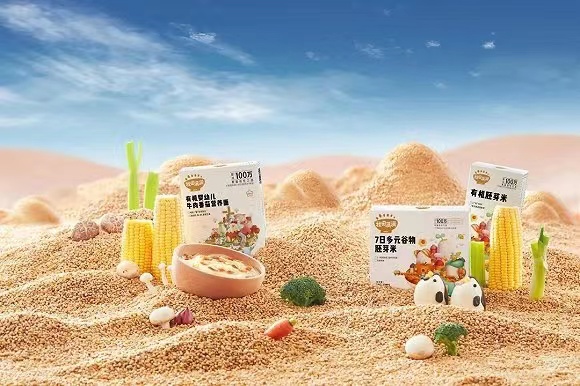"The rise of 100 billion mothers and infants auxiliary food circuit, the establishment and improvement of industry standards is imminent"
Author:Economic Observer Time:2022.09.27

Zhou Li is a newer mother after the 95th post -95s. When the child was weaned, he considers what the child eats and how to eat. As an indigenous people, she likes to learn and share childcare experience in communities, communities, and short video platforms, while paying more attention to the scientific feeding and nutritional structure of the baby.
Under Bao Ma's grass, Zhou Li decided to choose the appropriate complementary food for the child. When choosing, she was in trouble in the face of strange "infant labels".
What is "infant label"? What are the differences between zero -supplementary food produced according to infant standards? How to choose the dazzling baby standard products in the market? Can you eat the supplementary food without the "baby label"?
There are not a few Bao Ma who is similar to Zhou Li. Today, the younger generation of the younger generation of the post -90s and post -95s pays more attention to scientific feeding of infants and young children. Zero supplementary food for "natural, safe, healthy, and nutritious" has become the demand of more and more treasure mothers. People's vision.
The truth and confusion of "infant standard"
Infant food supplement refers to auxiliary foods that supplement their babies in addition to breast milk and baby formula milk powder at the infant stage. Common baby rice noodles, noodles, all kinds of meat mud, mud, biscuits, and molar rods. Similar to other foods, the market is also intensifying, while consumers have difficulty choosing, the quality and safety of infants and young children's supplementary food have become a major test in the industry.
In fact, in addition to infants and young children's food, whether the labels of other food labels are "zero added", "pure natural", or food additives during food production, as long as it complies with relevant laws and regulations and food safety standards in my country All are safe.
But infant food is an exception, especially the auxiliary food category called "baby second meals" except milk powder, which requires more stringent standards. "Baby label" is the country's standard for infant food, and is a symbol of quality assurance and food safety.
In order to meet the nutritional needs of infants and young children, the biggest difference between the product and the implementation of other "National Standards for Food Safety" is the requirements of nutritional enhancement. And compared to industry standards, the infant standard will be relatively strict in the scope and detection limit of some regulations.
In addition, for factories that can produce "infant standards" supplementary food, there are also strict "Infant Food Production License Examination Rules", which have stricter requirements in process production, safety, health, testing, and nutritional enhancement.
At present, infant food standards under the national compulsory standards include the "Food Safety National Standard Infant Grain Foods" (GB 10769-2010) and "Food Safety Standard Infant Assistance Food" (GB 10770- 2010), mainly for grain supplementary foods (processing and adding nutritional reinforcements), such as strengthening rice noodles, molar rods, etc., supplementary foods made of grains and canned foods.
In these two types of complementary foods, consumers are the first choice for "infant standards" products. However, there are fewer categories under the "infant standard". Categories outside the "infant standard" such as rice, oats, nuts, cheese yogurt, and bread snacks, which also causes consumers to be confused when choosing a choice.
Zhou Li's confusion in the selection of supplementary food is not a case. With the post -90s and post -95s, she became the main force of infants and young children. Choose suitable products.
But this is too difficult. "On the one hand, there is no time to learn, and the second thing really needs professional knowledge." Zhou Li expressed helplessness. "Is there no simple and easy -to -understand purchase standard in the market?"
Opportunities and challenges of domestic brands
As the consumption upgrade and the three -child policy will be fully liberalized, infant supplementary food may usher in new development opportunities. According to China's population planning goals, the number of new population in 2020 and 2030 must reach at least 22.3 million and 14.55 million. If the number of freshmen is maintained at about 15 million each year, the 1-3-year-old infant in my country will exceed 45 million in the next three years.
The large population base of infants and young children has brought the foundation for high -speed growth to the supplementary food market for infant and young children. Although the market is large, the penetration rate of food supplementary food in my country is not high. Data show that compared with 80%of foreign data, the penetration rate of Chinese infant supplementary food is only 25%.
In addition, compared with foreign countries, my country's infant supplementary food industry starts late and is still in a relatively early stage. However, for a long time, the infant food supplementary food market in the domestic market has been divided into market share by some foreign brands or "fake foreign cards".
However, due to factors such as dietary structure, dietary habits, economic level, and racial differences, the nutritional levels of various countries are very different, so that there are great differences in the demand for infants and young children in various countries. For example, children in Europe and the United States are not universal due to the lack of vitamin A, so they emphasize vitamin D to infants and young children, but Chinese babies need to supplement vitamin A and D.
"Suitable for Chinese babies" has become the effort of many domestic infant supplementary food brands.
A large number of domestic brands have risen. Not only did the Akita Manchu, Little Deer Blue, Mi Xiaoya, and Wo Xiaoya emerged, but also traditional food giants such as COFCO Grain Valley and Liangpinpu also entered the game. It is reported that there are currently more than 500 infant supplementary food brands in the domestic market.
A industry insider said: "The development of new domestic goods is not only based on the improvement of the entire society's cognition of domestic brand, but also the reshaping of the brand in the new media environment. Reflect. "However, the industry's concerns behind the hotness. In the infant market, because most supplementary food companies do not have strong scientific and technological strength, many manufacturers can only rely on imitating the survival of competing products. The core competitiveness and brand personality of the brand can be simply lacking. Severe, lack of innovation and insufficient product power.
In addition, the "infant label" problem that plagues consumers and the industry has not yet been resolved. The domestic infant supplementary food brand is bound to have a long way to go.
Higher standards, perhaps the best solution to the industry
In fact, industry players have a deep physical sensation about the above industry problems. Coupled with the drive of various parties such as policies, consumers, etc., the infant supplementary food industry is also upgrading in the direction of professionalism and refinement, and higher standards may be an important breakthrough at present.
Why does the industry spare no effort to raise industry standards so much? According to the "Healthy China 2030" plan and the spirit of "Healthy China Action (2019-2030)", it is an important part of children's health and strengthening early development of children.
Yu Xiaoqian, Executive Vice President and Secretary -General of the Chinese Maternal and Child Health Association, said that the health of infants and young children is related to the national economy and people's livelihood. From the Millennium goals of the United Nations to the development of the development of various countries, they have pointed to the health of women and children's health, especially in the early 1,000 days of infants and young children to life. importance. At this stage, nutrition, maintenance, care, body, psychology, especially brain development, is important to children's life, and this has also been consensus from the country and the world.
Based on this, many brands have begun to extend to the upper reaches of the industrial chain to establish factories and form a research and development team. For example, under the guidance of the Chinese Maternal and Child Health Association and Experts, Akita is studying the refined split feeding system of Chinese babies, proposing a standard for supplementary food supplement for infants and children, and establishing April to 6 years old to each stage. Reference standards and nutritional intakes that need to be paid attention to, and a week's auxiliary snacks.
For example, the three squirrels plan to be led by the government and cooperate with high -quality suppliers to co -build a manufacturing processing plant with high -quality suppliers. The three squirrels will invest in light assets to participate in the supervision and control of the manufacturing end in a certain degree of subsequent extent.
Long -termism and social responsibility
The Ministry of Commerce's Circulation Industry Promotion Center mentioned in the "Snack Industry Development Report in the Background of Consumption Upgrade" that the upgrade of enterprises requires social responsibility upgrades, and fulfilling social responsibilities has become a must -have concept of operators.
As a starting point of life, infant supplementary food requires higher and more comprehensive technical requirements and product guarantees. This requires companies to not only align with the "infant standard", but also require a wide range of coverage of the industry. Specifies to ensure food safety of infants and young children.
In this regard, we can see the efforts of the industry participating in all parties. On September 25th, at the "Chinese Infant Food and Feeding Guidelines" expert seminar on September 25, industry experts, academic, medical circles, and enterprises feeding supplementary food in infant nutrition management and scientific credentials Progress of health career.
At the meeting, Akita Manchu provided an analysis of the comprehensive research results of the interview survey of 3000+ users and 30000+ online surveys from one year, 3000+ users. Together with digital pediatricians, nutritionists, parentingists, dentists and other experts, they began to think about how to help millions of Chinese children's families establish a scientific feeding system and promote industry standards. And released the "Chinese Infant Fate Food and Feeding Guidelines".
At the moment of standing at the moment, we have reason to believe that with the attention and continuous efforts of infants and young children from all walks of life, the scientific, nutritional, health standards and scientific feeding systems constructed by the "Guide" will also be accelerated. The significance of its landing is not only the responsibility of all sectors of society, but also the expectations of consumers. The implementation of this process is also the determination of corporate practice to maintain long -termism and coexist with the industry.
- END -
Nike "falls" in China: the net profit of revenue increased, and the digital business could not run Keep

Author | Xiong YueOn June 27, the international sports brand Nike released the four...
Expert: LPR quotation in July remains unchanged, and LPR reduction of more than 5 years is still expected
MLF is constant and the net interest difference between banks and banks, in July LPR quotation remains unchangedThe quotes of LPR and more than 5 -year LPRs in July 1st remained unchanged. The main re